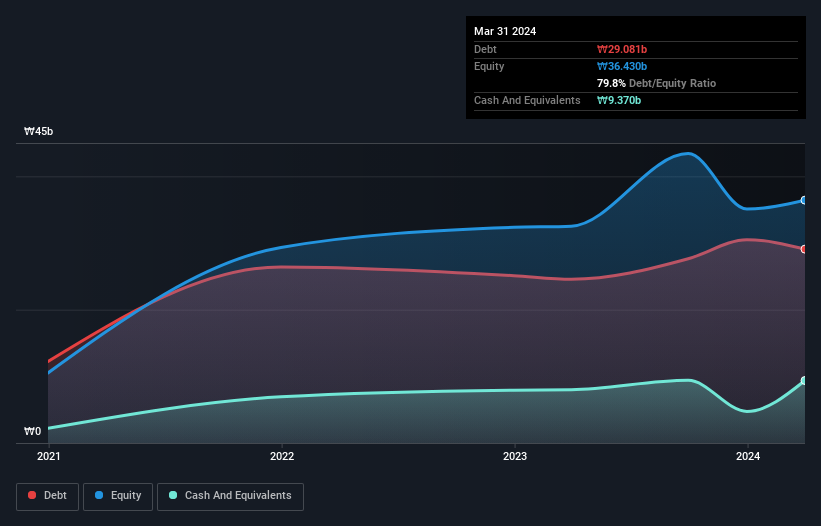- South Korea
- /
- Personal Products
- /
- KOSDAQ:A406820
Beauty Skin (KOSDAQ:406820) Is Making Moderate Use Of Debt

Howard Marks put it nicely when he said that, rather than worrying about share price volatility, 'The possibility of permanent loss is the risk I worry about... and every practical investor I know worries about.' When we think about how risky a company is, we always like to look at its use of debt, since debt overload can lead to ruin. As with many other companies Beauty Skin Corp. (KOSDAQ:406820) makes use of debt. But should shareholders be worried about its use of debt?
When Is Debt A Problem?
Generally speaking, debt only becomes a real problem when a company can't easily pay it off, either by raising capital or with its own cash flow. In the worst case scenario, a company can go bankrupt if it cannot pay its creditors. However, a more common (but still painful) scenario is that it has to raise new equity capital at a low price, thus permanently diluting shareholders. Of course, plenty of companies use debt to fund growth, without any negative consequences. When we think about a company's use of debt, we first look at cash and debt together.
View our latest analysis for Beauty Skin
How Much Debt Does Beauty Skin Carry?
As you can see below, at the end of March 2024, Beauty Skin had ₩29.1b of debt, up from ₩24.6b a year ago. Click the image for more detail. However, it also had ₩9.37b in cash, and so its net debt is ₩19.7b.

A Look At Beauty Skin's Liabilities
The latest balance sheet data shows that Beauty Skin had liabilities of ₩36.2b due within a year, and liabilities of ₩1.84b falling due after that. Offsetting these obligations, it had cash of ₩9.37b as well as receivables valued at ₩19.9b due within 12 months. So its liabilities outweigh the sum of its cash and (near-term) receivables by ₩8.80b.
Since publicly traded Beauty Skin shares are worth a total of ₩78.6b, it seems unlikely that this level of liabilities would be a major threat. But there are sufficient liabilities that we would certainly recommend shareholders continue to monitor the balance sheet, going forward. When analysing debt levels, the balance sheet is the obvious place to start. But it is Beauty Skin's earnings that will influence how the balance sheet holds up in the future. So when considering debt, it's definitely worth looking at the earnings trend. Click here for an interactive snapshot.
In the last year Beauty Skin wasn't profitable at an EBIT level, but managed to grow its revenue by 42%, to ₩84b. Shareholders probably have their fingers crossed that it can grow its way to profits.
Caveat Emptor
Even though Beauty Skin managed to grow its top line quite deftly, the cold hard truth is that it is losing money on the EBIT line. To be specific the EBIT loss came in at ₩5.3b. Considering that alongside the liabilities mentioned above does not give us much confidence that company should be using so much debt. So we think its balance sheet is a little strained, though not beyond repair. Another cause for caution is that is bled ₩12b in negative free cash flow over the last twelve months. So suffice it to say we consider the stock very risky. There's no doubt that we learn most about debt from the balance sheet. However, not all investment risk resides within the balance sheet - far from it. For example, we've discovered 4 warning signs for Beauty Skin (3 can't be ignored!) that you should be aware of before investing here.
At the end of the day, it's often better to focus on companies that are free from net debt. You can access our special list of such companies (all with a track record of profit growth). It's free.
Valuation is complex, but we're here to simplify it.
Discover if Beauty Skin might be undervalued or overvalued with our detailed analysis, featuring fair value estimates, potential risks, dividends, insider trades, and its financial condition.
Access Free AnalysisHave feedback on this article? Concerned about the content? Get in touch with us directly. Alternatively, email editorial-team (at) simplywallst.com.
This article by Simply Wall St is general in nature. We provide commentary based on historical data and analyst forecasts only using an unbiased methodology and our articles are not intended to be financial advice. It does not constitute a recommendation to buy or sell any stock, and does not take account of your objectives, or your financial situation. We aim to bring you long-term focused analysis driven by fundamental data. Note that our analysis may not factor in the latest price-sensitive company announcements or qualitative material. Simply Wall St has no position in any stocks mentioned.
About KOSDAQ:A406820
Beauty Skin
Manufactures, markets, and distributes cosmetics in South Korea.
Good value with adequate balance sheet.
Market Insights
Community Narratives



